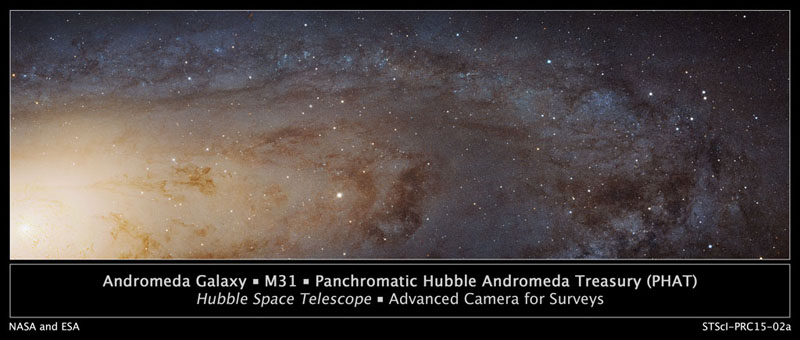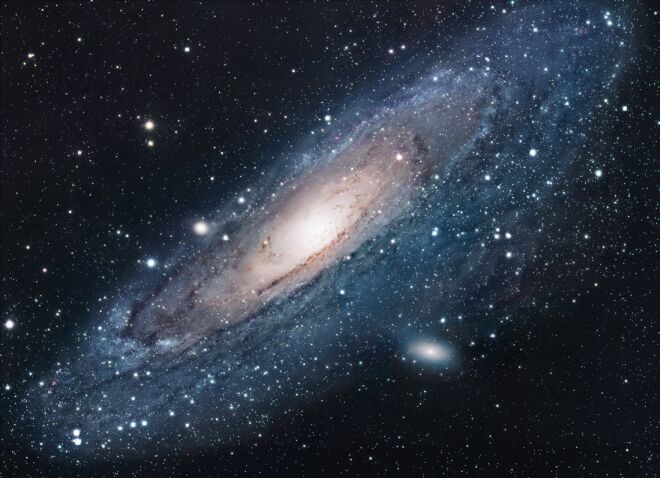| ANDROMEDA |
|
Created 2003 Updated 6 Jan 2014 |
 |
|
http://www.andromeda.com/scienceastronomy/050530_andromeda_size.html |
|
June 2006: Evidence that Andromeda is 3 times bigger than first thought. The implication is that the disk is 260,000 light years in diameter, instead of the earlier estimates of 70,000 to 80,000 light years. In our sky, that means Andromeda stretches out over the length of 12 full Moons. The distance to Andromeda is now estimated at 2.52 million light years (and closing!). Andromeda is a large constellation of the northern hemisphere. Just south of Cassiopeia, west of Perseus. The main feature of this constellation is the galaxy of the same name. Andromeda is part of the "local group of galaxies" of which we are a member. Andromeda is 2.2 million light years from us, the closest spiral galaxy to us and also the farthest object that can be seen with the naked eye. Before modern telescopes depicted Andromeda in all its glory, it was believed to be a nebula or cloud of interstellar gas. Andromeda has two small companions, two elliptical galaxies. Recent notes I have read on web sites are claiming that Andromeda is actually moving away us, but Andromeda is in the "blue shift" of the spectrum, meaning it is moving towards us at a speed of 300, 000 MPH. A bit of conflicting information there! However, it will not happen for 5 billion years and will take another 10 billion years for the new, single, galaxy to settle down. When I first started my page on this in 2003 I searched the internet for info. Encarta states it is moving away. Strangely enough, Funk & Wagnall states exactly the same info in exactly the same terminology, word for word - who copied who? Both of these have it wrong as it is definitely moving towards us! So much for informative encyclopaedias! http://hubblesite.org/discoveries/cosmic_collision/cosmic-movie.shtml for a video representation of how Andromeda will affect the Milky Way ands cause its demise. When I relate to distances on these pages please remember that we are talking of distances in both andromeda and time! You are looking at a night sky, at for example Andromeda, you are looking at an image that is 2.5 million lights years old! That is the amount of time/distance it has takes the light (image) of this galaxy to reach your eye. The following bit of info is copied from a site known as the Andromeda Observatory and can be found at: An excellent site of an astronomer called Kevin Deakes. "Although challenged by the large galaxy in Triangulum (M33), the Andromeda Galaxy is generally regarded as the most distant object visible to the human eye. At a distance of 2.2 million light years, it appears as a fuzzy patch of light in the night sky. In fact, only the bright core of the galaxy is seen, the full extent of the galaxy covers over 3° of sky on its longest side. The galaxy is the largest member of the Local Group, a group of about 30 galaxies that includes both our own Milky Way and M33. It contains approximately twice the number of stars as our Galaxy and is about 125,000 light years in diameter. It is a spiral galaxy of type Sb (a spiral with fairly tight wound arms) inclined at an angle of 15° to our line of sight. Like our Galaxy, it has two prominent satellite galaxies, M32 and NGC 205, both of which are small ellipticals. Observations with the Hubble andromeda Telescope suggest that the Andromeda Galaxy may have two cores. This is thought to be the result of a past merger with another galaxy. Such processes were once common in the Universe and still occur today. Indeed, the galaxy is approaching us at a speed of 68 kilometres per second and a collision with the Milky Way is a possibility in the distant future." Kevin Deakes. An article on www.andromeda.about.com
In case you don't have enough to worry about, astronomers say the Milky Way -- our home galaxy -- is destined to be involved in a disastrous intergalactic collision with Andromeda. The good news is, it won't happen for another 6 billion years from now, so we have plenty of time to plan. Our Milky Way is 100,000 light-years across and contains over 100 billion stars. The neighbouring Andromeda galaxy, at least as massive as the Milky Way, is visible in the autumn sky as a small spindle-shaped smudged of light located 2.2 million light years away, but it's headed this way at over one million miles per hour. Astronomers don't know for sure if we're in store for a head-on collision or a mere sideswipe. Future telescopes will make precise enough observations to tell for sure, but supercomputer simulations show the collision will cause the Milky Way and Andromeda galaxy to merge together into a single, giant elliptical galaxy. The Andromeda galaxy will likely first swing by our galaxy and then take perhaps 100 million years to make a slow U-turn before plunging into the Milky Way's core. Hubble andromeda Telescope views of spectacular collisions between other pairs of spiral galaxies in the universe have already given astronomers a preview of what's in store for the Milky Way. The night time ribbon and stars and dust that marked the lanes of our Milky Way will begin to come apart under the gravitational tug-of-war between the two galaxies. The sky will grow increasingly jumbled with shreds of black dust, glowing gas, and "superclusters" of brilliant blue stars. Cold, black molecular clouds will be compressed and heated until they burst apart in a firestorm of starbirth. Supernova explosions from the most massive of the newborn stars will pepper the heavens with titanic blasts going off like a string of firecrackers. As the stars gravitationally settle into their new home, any hint of the Milky Way and Andromeda as majestic spiral galaxies will be gone. Far-future alien sky watchers will gaze into a rich starry sky and look all the way across andromeda into the brilliant core of our newly formed elliptical galaxy. |
 |
| The ring-like swirls of dust filling the Andromeda galaxy stand out colorfully in this new image from the Herschel andromeda Observatory, a European andromeda Agency mission with important NASA participation. The glow seen here comes from the longer-wavelength, or far, end of the infrared spectrum, giving astronomers the chance to identify the very coldest dust in our galactic neighbor. These light wavelengths span from 250 to 500 microns, which are a quarter to half of a millimeter in size. Herschel's ability to detect the light allows astronomers to see clouds of dust at temperatures of only a few tens of degrees above absolute zero. These clouds are dark and opaque at shorter wavelengths. The Herschel view also highlights spokes of dust between the concentric rings. The colors in this image have been enhanced to make them easier to see, but they do reflect real variations in the data. The very coldest clouds are brightest in the longest wavelengths, and colored red here, while the warmer ones take on a bluish tinge. These data, together with those from other observatories, reveal that other dust properties, beyond just temperature, are affecting the infrared color of the image. Clumping of dust grains, or growth of icy mantles on the grains towards the outskirts of the galaxy, appear to contribute to these subtle color variations. These observations were made by Herschel's spectral and photometric imaging receiver (SPIRE) instrument. The data were processed as part of a project to improve methods for assembling mosaics from SPIRE observations. Light with a wavelength of 250 microns is rendered as blue, 350-micron is green, and 500-micron light is red. Color saturation has been enhanced to bring out the small differences at these wavelengths. Text - NASA. Image credit: ESA/NASA/JPL-Caltech/NHSC |
| Sources included
Encarta 97*, Funk & Wagnall* and Maris' Redshift 2, a Russian product,
Andromeda Observatory (Kevin Deakes), NASA and Discovery web sites *Encarta 97 and F&W (One copied from the other) are both in error as they stated that Andromeda was moving AWAY from us. |
|
http://www.dmuller.net/cosmology/andromeda.php
including time scale countdown to the arrival of Andromeda
http://www.solstation.com/x-objects/andromeda.htm |
|
ANDROMEDA Andromeda in mythology was a princess of Ethiopia. As is usual in Greek mythology, Andromeda was supposed to be sacrificed to appease some monster or other but was rescued by Perseus, who slew the monster, then married Andromeda and I suppose they lived happily ever after! Those Greeks were a bloodthirsty lot!
|